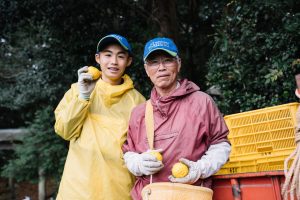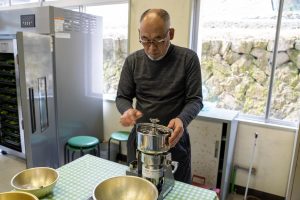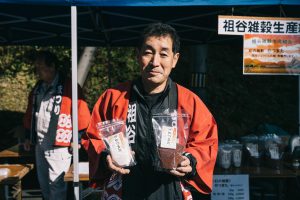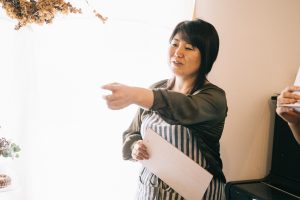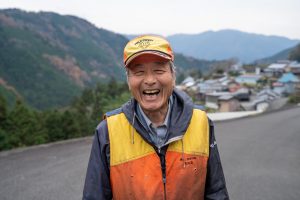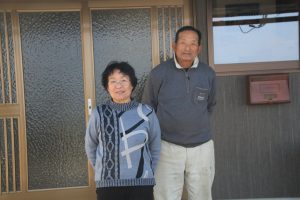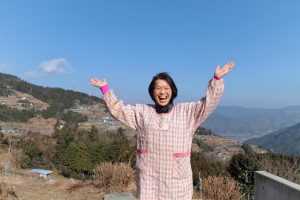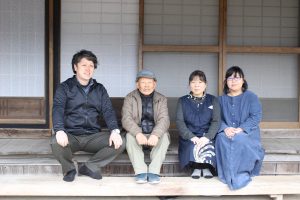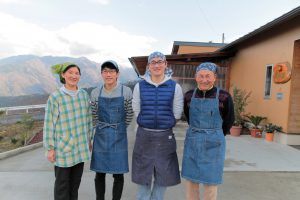Interview
Yoshinobu Amata|The People Supporting Globally Important Agricultural Heritage System
Yoshinobu Amata (Koyadaira, Mima City) Koyadaira in Mima City, located at the foot of Mount Tsurugisan, is known as the yuzum-producing area. Mr. Yoshinobu Amata officially began yuzu cultivation in Koyadaira. When sericulture declined in 1963, he focused on cultivating Yuzu because it sold at a high price. At first, it was said that Koyadaira was unsuitable for yuzu cultivation; however, the cultivation was successful and spread throughout Koyadaira. In the middle of 1975, the price of Yuzu was sometimes as high as JPY 6,000–JPY 7,000 for a box of 12. However, prices began to fall, reaching approximately 60 yen per kilogram, when it was cheapest in 1985. Mr. Amata […]
Norouchi Vegetable Processing and Producing Association|The People Supporting Globally Important Agricultural Heritage System
Norouchi Vegetable Processing and Production Association (Ikeda Town in Miyoshi City) The Kaminoro district of Ikeda town in Miyoshi City is located in the mountains at an altitude of 400–500 m above sea level. The area was originally a prosperous agricultural area where leaf tobacco was cultivated, and tomatoes and other summer vegetables are now grown in the area. In the Kaminoro district, 22 farm households have formed a vegetable processing and production association called " Aikurushii Yum-Yum" to revitalize an area that is losing vitality due to depopulation, aging of the population, and increasing abandonment of cultivated land. The product is a powder made from dried vegetables that cannot […]
Iya Millet Products Association|The People Supporting Globally Important Agricultural Heritage System
Iya Millet Products Association (Higashi-Iya in Miyoshi City) The Iya region of Miyoshi city is among the three unexplored regions of Japan. In this region, indigenous millets have been cultivated with buckwheat and other crops. One of the most valuable indigenous millets cultivated in this region is "Yatsumata (Finger millet)." Yatsumata (Finger millet) belongs to the grass family and is native to Eastern Africa. In Japan, it was cultivated mainly in mountainous regions such as Shikoku. Nowadays, it is popular as a superfood owing to its high nutritional value. People in Higashi-Iya have made considerable efforts to preserve Yatsumata. A man, who was the only producer of Yatsumata in Higashi-Iya, […]
Masumi Yoshida|The People Supporting Globally Important Agricultural Heritage System
Masumi Yoshida (Anabuki Town in Mima City / Ni to Ha・ruche CAHOA) The popular café ruche, CAHOA, is located in Anabuki Town, Mima City. Mrs. Masumi Yoshida owns this café, and her teenagers are popular among customers locally and from other prefectures. In 2019, she launched a project that covered everything from tea cultivation to commercialization because she wanted to pass on local tea, which has long been cultivated extensively in mountainous areas, to the next generation. She organized a "Ni to Ha" group with about ten local people in their 30s and 40s who agreed to participate in the project. They borrow a tea farm from Mr. Yasuo Koizumi, […]
Masao Kinoshita|The People Supporting Globally Important Agricultural Heritage System
Masao Kinoshita ( Higashi Miyoshi Town, Guest House, Uribou ) Mr Kinoshita has been an office worker for nearly 40 years. He has been managing guesthouses for approximately six years. It has become so famous that nearly 500 people visit annually for overnight stays, tours, and agricultural experiences. Mr. Kinoshita's daily routine appears busy. For example, "In winter, I patrol wild boar traps, check mountain roads, work in fields, and maintain farm equipment. I spend more time farming because of the longer daylight hours in summer. No time to rest when I welcome guests because I need to prepare for their dinner." However, he seemed happy to enjoy living there. He said, […]
Chiyoko Yamamoto and Yasuo Koizumi|The People Supporting Globally Important Agricultural Heritage System
Chiyoko Yamamoto and Yasuo Koizumi (Anabuki Town in Mima City / Farmer's Guest House Yamamotoya) We arrived at Fuchimyou after driving about 40 minutes from the Wakimachi InterChange. Although this village is mountainous, the slope is gentler in many places than in other areas. The farmer's guest house, "Yamamotoya," is run by an energetic mother. She is Mr. Koizumi's younger sister and the head of this area's community association. She returned to Mima from Osaka, where she had lived for many years, and started a second life in the family home where she was born and raised. She said, "Children who come to experience farming say that the vegetables grown […]
Yoko Ando|The People Supporting Globally Important Agricultural Heritage System
Yoko Ando (Higashi-Miyoshi Town / Guest House Ando) "Guest House Ando (also known as Anchan's house)" is located 460 meters above sea level in Higashi-Miyoshi Town and has welcomed many guests from Japan and abroad in response to the call for hands-on educational tours and tourism projects conducted by "General Incorporated Association Sora no Sato." From Japanese urban junior high school and high school students to international exchange, children and adults from Cambodia, Malaysia, Korea, Taiwan, and other countries can come here. They experience seasonal farm work and taste local cuisine with lots of vegetables from here. "When I show them around by car, at first, everyone is surprised to […]
Shinsuke Nakayama, Mari Nakayama, Kumiko Hiura, and Haruyoshi Moriwaki|The People Supporting Globally Important Agricultural Heritage System
Shinsuke Nakayama, Mari Nakayama, Kumiko Hiura and Haruyoshi Moriwaki (Higashi-Iya in Miyoshi City / Guest house Kouya) Here is Higashi-iya-kubo in Miyoshi city. It is a two-and-a-half-hour drive from Tokushima city. A young couple has started their own guest house, and it is no exaggeration to say that this is an unexplored region even though the roads are maintained. This is the house where Mari-san's father was born and raised. Her mother, Kumiko-san, wanted to keep the house but thought that "it would be too much for me to live there...." Then, her daughter and her husband decided to move in here. Mr. and Mrs. Nakayama said, "We had planned […]
Ootake Hajime|The People Supporting Globally Important Agricultural Heritage System
Ootake Hajime (Anabuki Town in Mima City / Farmer’s restaurant Fuwari) Mr. Hajime Ootake (rightmost in the photo) said, "I would like to recommend living in the countryside," with a smile. In March 2016, upon retirement, he and his family moved from Tokyo to Fuchimyou village, where his wife's hometown is located. He now runs a farmer's restaurant called "Fuwari" with his wife and sons. Fuchimyou village is located around 250 to 550 meters above sea level in Anabuki and is close to the mountaintop where steep slope land agriculture is carried out. Mr.Yasuo Koizumi has been a farmer for many years and is wondering about the future of his […]
Katsuyuki Isogai and Hamako Isogai|The People Supporting Globally Important Agricultural Heritage System
Katsuyuki Isogai and Hamako Isogai (Tsurugi Town) Isogai family's house is about 400 meters above sea level in the village of Mikidochi. Their surname, "Isogai," reminds me that the sea is strange because they have a house on a mountain, but Hamako said, "Our ancestors migrated from the Miura Peninsula in Kanagawa Prefecture." Looking through the old records, we can see that their ancestors migrated to this area more than 400 years ago. Katsuyuki said, "They were the first people to enter this village, so our business name is "Omoya." My great-grandfather collected the land tax around this area and went to Wakimachi with his sword to pay it in." […]

